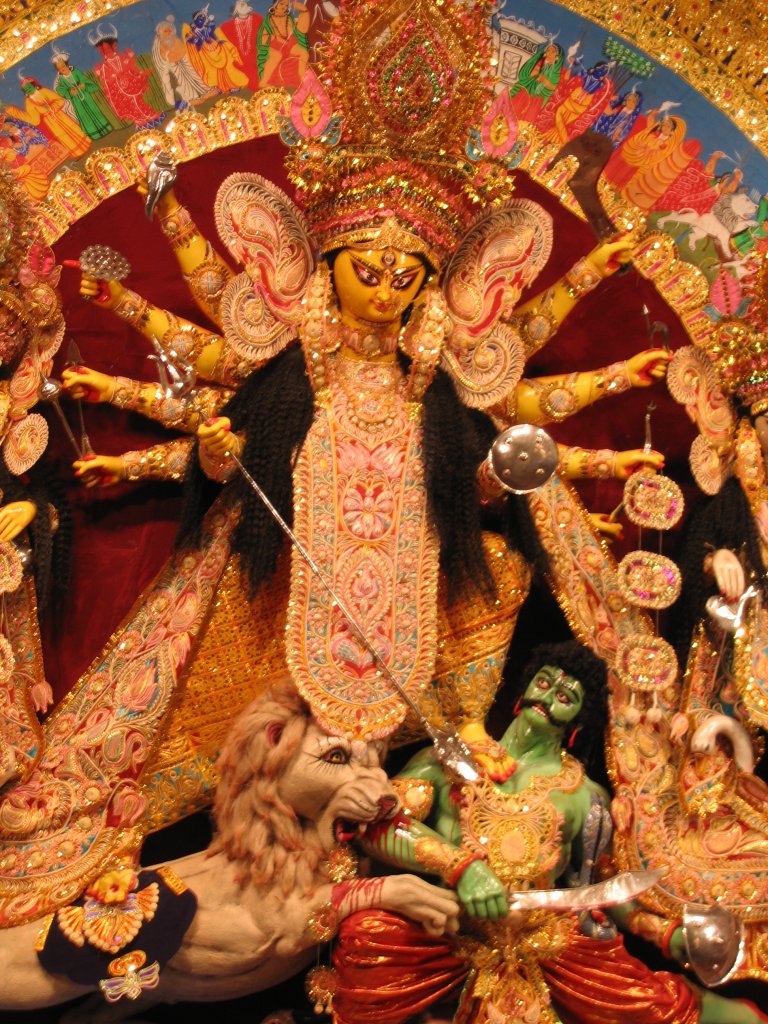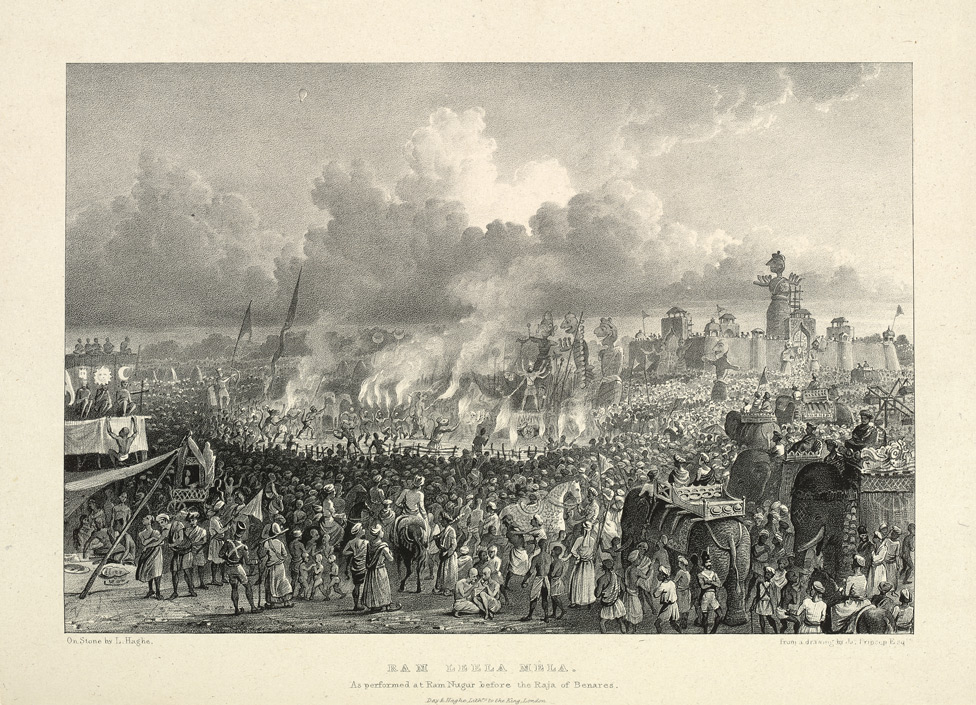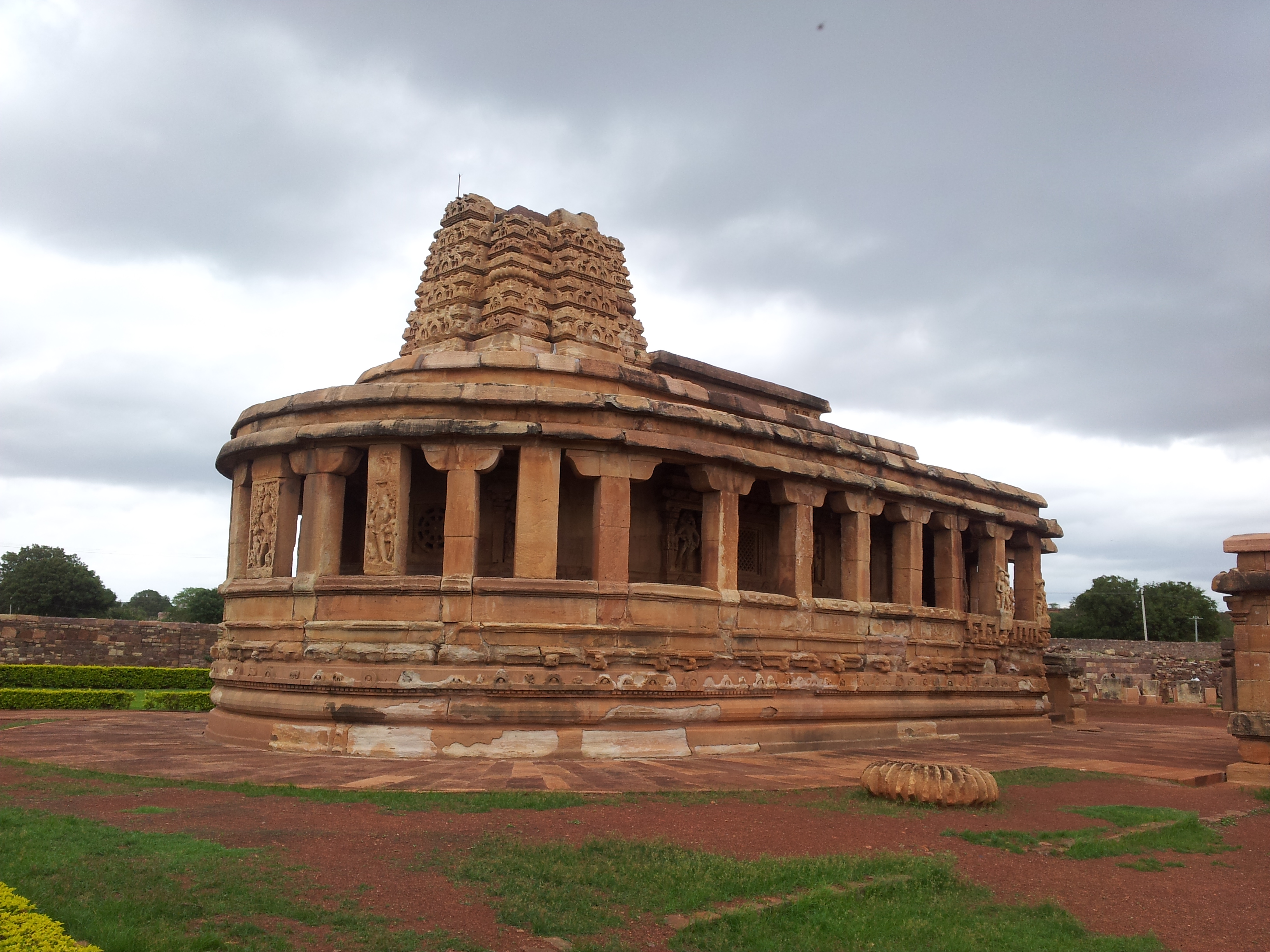|
Katyayani
''Katyayani'' (कात्यायनी) is an aspect of Mahadevi and the slayer of the tyrannical demon Mahishasura. She is the sixth among the Navadurgas, the nine forms of Hindu goddess Durga who are worshipped during the festival of Navaratri. She is depicted with four, ten or eighteen hands. This is the second name given to the goddess Adi Parashakti in Amarakosha, the Sanskrit lexicon (Goddess Parvati names- Uma, Katyayani, Gauri, Kali, Haimavati, Ishwari). In Shaktism, she is associated with the fierce forms of Shakti or Durga, a warrior goddess, which also includes Bhadrakali and Chandika. She is traditionally associated with the colour red, as with Parvati, the primordial form of Shakti, a fact also mentioned in Patanjali's Mahabhashya on Pāṇini, written in 2nd century BCE. She is first mentioned in the Taittiriya Aranyaka part of the Yajurveda. The Skanda Purana mentions her being created out of the spontaneous anger of Gods, which eventually led to slaying ... [...More Info...] [...Related Items...] OR: [Wikipedia] [Google] [Baidu] |
Yajnavalkya
Yajnavalkya or Yagyavalkya (, International Alphabet of Sanskrit Transliteration, IAST:) is a Hindu Vedic sage prominently mentioned in the Brihadaranyaka Upanishad (c. 700 BCE) and Taittiriya Upanishad, ''Tattiriya Upanishad''., Quote: "Yajnavalkya, a Vedic sage, taught..."Ben-Ami Scharfstein (1998), ''A comparative history of world philosophy: from the Upanishads to Kant'', Albany: State University of New York Press, pp. 9-11 Yajnavalkya proposes and debates metaphysics, metaphysical questions about the nature of existence, consciousness and impermanence, and expounds the epistemology, epistemic doctrine of neti neti ("not this, not this") to discover the Brahman, universal Self and Ātman (Hinduism), Ātman. Texts attributed to him include the ''Yajnavalkya Smriti'', ''Yoga Yajnavalkya'' and some texts of the Vedanta school. He is also mentioned in the ''Mahabharata'' as well as various Puranas, Brahmanas and Aranyakas. Name The name Yajnavalkya is derived from ''yajna'', whi ... [...More Info...] [...Related Items...] OR: [Wikipedia] [Google] [Baidu] |
Navratri
Navaratri () is an annual Hindu festival observed in honor of the goddess Durga, an aspect of Adi Parashakti, the supreme goddess. It spans over nine nights, first in the month of Chaitra (March/April of the Gregorian calendar), and again in the month of Ashvin (September–October). It is observed for different reasons and celebrated differently in various parts of the Hindu Indian cultural sphere. Theoretically, there are four seasonal ''Navaratris''. However, in practice, it is the post-monsoon autumn festival called Sharada Navaratri. There are 2 Gupta Navaratris or "Secret Navaratris" as well, one starting on the Shukla Paksha Pratipada of the Magha Month (Magha Gupta Navaratri) and another starting in the Shukla Paksha Pratipada of Ashadha Month. Etymology and nomenclature The word ''Navarātram'' means "a period of nine nights" in Sanskrit, ''nava'' meaning "nine" and ''ratri'' meaning "night". Dates and celebrations In the eastern and northeastern states of ... [...More Info...] [...Related Items...] OR: [Wikipedia] [Google] [Baidu] |
Navadurgas
Navadurga (, ), also spelled Navdurga and Navadurgas, are nine manifestations and forms of Durga in Hinduism, especially worshipped during Navaratri and Durga Puja. They are often considered collectively as a single deity, mainly among the followers of Shaktism and Shaivism sect of Hinduism. According to Hindu mythology, the nine forms are considered the nine stages of Durga during the nine-day long duration of the war with demon-king Mahishasura, where the tenth day is celebrated as the Vijayadashami () among the Hindus and is considered as one of the most important festivals. Background During the festival of Navaratri, nine unmarried virgin girls up to the age of nine years are worshipped and fed as they are considered to be the incarnations of these nine goddesses. The nabapatrika ritual during Durga Puja involves tying the branches of eight plants with their leaves with a banana plant (''naba'' meaning 'nine', and p''atrika'' meaning 'leaves'). The nine forms The main n ... [...More Info...] [...Related Items...] OR: [Wikipedia] [Google] [Baidu] |
Chandi
Chandi (, ) or Chandika () is a Hindu deity. Chandika is a form of goddess Durga. She shares similarities with the Goddess Chamunda, not only in name but also in attributes and iconography. Due to these similarities, some consider them to be the same deity, while others view them as different manifestations of Mahadevi. Both are often associated with other powerful goddesses like Durga, Katyayani, Kali and Kalaratri. The Goddess is particularly revered in Gujarat. History In the '' Devī Māhātmya.'' Chandi represents the killer of Chanda. the Supreme Divine is often referred to as Caṇḍī or Caṇḍikā. This name is derived from the Sanskrit root ''caṇḍa'', meaning “fierce” or “terrible.” Chandi is celebrated as the vanquisher of the demonic generals Chanda and Munda. According to Bhaskararaya, a prominent authority on Devi worship, Chandi embodies divine wrath and passion. The epithet of Chandi or Chandika appears in the Devi Mahatmya, a text dee ... [...More Info...] [...Related Items...] OR: [Wikipedia] [Google] [Baidu] |
Avatar
Avatar (, ; ) is a concept within Hinduism that in Sanskrit literally means . It signifies the material appearance or incarnation of a powerful deity, or spirit on Earth. The relative verb to "alight, to make one's appearance" is sometimes used to refer to any guru or revered human being. The word ''avatar'' does not appear in the Vedic literature; however, it appears in developed forms in post-Vedic literature, and as a noun particularly in the Puranic literature after the 6th century CE. Despite that, the concept of an avatar is compatible with the content of the Vedic literature like the Upanishads as it is symbolic imagery of the Saguna Brahman concept in the philosophy of Hinduism. The ''Rigveda'' describes Indra as endowed with a mysterious power of assuming any form at will. The ''Bhagavad Gita'' expounds the doctrine of Avatara but with terms other than ''avatar''. Theologically, the term is most often associated with the Hindu god Vishnu, though the idea has been ... [...More Info...] [...Related Items...] OR: [Wikipedia] [Google] [Baidu] |
Durga
Durga (, ) is a major Hindu goddess, worshipped as a principal aspect of the mother goddess Mahadevi. She is associated with protection, strength, motherhood, destruction, and wars. Durga's legend centres around combating evils and demonic forces that threaten peace, prosperity, and dharma, representing the power of good over evil. Durga is believed to unleash her divine wrath against the wicked for the liberation of the oppressed, and entails destruction to empower creation. Durga is seen as a motherly figure and often depicted as a beautiful woman, riding a lion or tiger, with many arms each carrying a weapon and often defeating demons. She is widely worshipped by the followers of the goddess-centric sect, Shaktism, and has importance in other denominations like Shaivism and Vaishnavism. The most important texts of Shaktism, Devi Mahatmya and Devi Bhagavata Purana, revere Devi (the Goddess) as the primordial creator of the universe and the Brahman (ultimate truth and reali ... [...More Info...] [...Related Items...] OR: [Wikipedia] [Google] [Baidu] |
Devi Mahatmyam
The ''Devi Mahatmya'' or ''Devi Mahatmyam'' () is a Hindu philosophical text describing the Goddess, known as Adi Parashakti or Durga, as the supreme divine ultimate reality and creator of the universe. It is part of the Mārkandeya Purāna (chapters 81 to 93). ''Devi Mahatmyam'' is also known as the ''Durgā Saptashatī'' () or Śata Chandī (शत् चंडी) and ''Chandi Path'' (). The text contains 700 verses arranged into 13 chapters. It is one of the most important texts in Shaktism, along with ''Devi-Bhagavata Purana'' and Devi Upanishad. The text is one of the earliest extant complete manuscripts from the Hindu traditions which describes reverence and worship of the feminine aspect of God. The ''Devi Mahatmyam'' describes a storied battle between good and evil, where the Devi manifesting as goddess Durga leads the forces of good against the demon Mahishasura—the goddess is very angry and ruthless, and the forces of good win. The verses of this story also ou ... [...More Info...] [...Related Items...] OR: [Wikipedia] [Google] [Baidu] |
Durga Puja
Durga Puja (ISO 15919, ISO: , ), also known as Durgotsava or Shaaradotsava, is an annual festival originating in the Indian subcontinent which pays homage to the Hinduism, Hindu goddess Durga, and is also celebrated because of Durga's victory over Mahishasura. It is the biggest festival of Bengali Hindus and the Indian state of West Bengal. Durga Puja in Kolkata, Durga Puja as celebrated in Kolkata, West Bengal's capital city, was inscribed on the UNESCO Intangible Cultural Heritage Lists, intangible cultural heritage list of UNESCO in December 2021. In addition to West Bengal, Hindu Bengalis are native to Bangladesh and Indian state of Tripura, Barak Valley, Assam (Barak Valley), Jharkhand and Kosi-Seemanchal, Bihar (Kosi-Seemanchal); Therefore, Durga Puja is performed with great devotion in these places as well. The festival is observed in the Indian calendar in the month of Ashwin, Ashvin, which corresponds to September–October in the Gregorian calendar. Durga Puja is ... [...More Info...] [...Related Items...] OR: [Wikipedia] [Google] [Baidu] |
Skanda Purana
The ''Skanda Purana'' ( IAST: Skanda Purāṇa) is the largest '' Mukhyapurāṇa'', a genre of eighteen Hindu religious texts. The text contains over 81,000 verses, and is of Shaivite literature, titled after Skanda, a son of Shiva and Parvati (who is also known as Murugan in Tamil literature). While the text is named after Skanda, he does not feature either more or less prominently in this text than in other Shiva-related Puranas. The text has been an important historical record and influence on the Hindu traditions and rituals related to the war-god Skanda. The earliest text titled ''Skanda Purana'' likely existed by the 8th century CE, but the ''Skanda Purana'' that has survived into the modern era exists in many versions. It is considered as a living text, which has been widely edited, over many centuries, creating numerous variants. The common elements in the variant editions encyclopedically cover cosmogony, mythology, genealogy, dharma, festivals, gemology, temples ... [...More Info...] [...Related Items...] OR: [Wikipedia] [Google] [Baidu] |
Yajurveda
The ''Yajurveda'' (, , from यजुस्, "worship", and वेद, "knowledge") is the Veda primarily of prose mantras for worship rituals.Michael Witzel (2003), "Vedas and Upaniṣads", in ''The Blackwell Companion to Hinduism'' (Editor: Gavin Flood), Blackwell, , pages 76–77 An ancient Vedic Sanskrit text, it is a compilation of ritual-offering formulas that were said by a priest while an individual performed ritual actions such as those before the yajna fire. Yajurveda is one of the four Vedas, and one of the scriptures of Hinduism. The exact century of Yajurveda's composition is unknown, and estimated by Witzel to be between 1200 and 800 BCE, contemporaneous with Samaveda and Atharvaveda. The Yajurveda is broadly grouped into two – the "black" or "dark" (''Krishna'') Yajurveda and the "white" or "bright" (''Shukla'') Yajurveda. The term "black" implies "the un-arranged, unclear, motley collection" of verses in Yajurveda, in contrast to the "white" which implies ... [...More Info...] [...Related Items...] OR: [Wikipedia] [Google] [Baidu] |
Bhadrakali
Bhadrakali (IAST: Bhadrakālī; ) is an important goddess, mainly worshiped by Hindus, and is a form of Kali. She is considered to be the auspicious and fortunate form of Adi Shakti or Durga, the supreme mother who protects the good, known as ''Bhadra or Bhadra Bhagavathy''. She is worshipped predominently in the South indian state of Kerala and Nashik. In Vaishnavism, Bhadrakali is among the many epithets of Yogamaya, the internal potency of illusion of the supreme preserver deity, Vishnu. In Shaivism, she accompanies Virabhadra, a form of Shiva, as manifestations of Shiva's wrath. Etymology The name Bhadra comes from Sanskrit. In Sanskrit, "bhadra" means "auspicious" or "fortunate". Another interpretation traces the name to the Sanskrit root word (Beeja akshara) "bha" and "dra". The letter "bha" signifies "delusion" or "maya", while "dra" is used as a superlative meaning "the most" or "the greatest". Together, "bhadra" may mean "maha maya" or "great delusion". Forms Acc ... [...More Info...] [...Related Items...] OR: [Wikipedia] [Google] [Baidu] |
Taittiriya
The ''Taittirīya Shakha'' (Sanskrit, loosely meaning 'Branch or School of the sage Tittiri'), is a ''shakha'' (i.e. 'branch', 'school', or rescension) of the Krishna (black) Yajurveda. The Taittiriyas are themselves divided into numerous sub-schools. Among these, the followers of Baudhayana and Apastamba were found all over South India (including Maharashtra), while the Hiranyakeshins were found mainly in Konkan and Western Maharashtra. The Vaikhanasas have a more eastern presence- around Tirupati and Chennai. The Vadhulas are present currently in Kerala and earlier in adjacent parts of Tamil Nadu. The Agniveshyas, a subdivision of the Vadhula immigrants from Malabar, are found around Thanjavur in Tamil Nadu. The Apastamba, Hiranyakeshin, Vaikhanasa and Baudhayana schools have survived with all their texts intact, it consists of the ''Taittirīya Samhita'' ('TS'), ''Taittirīya Brahmana'' ('TB'), ''Taittirīya Aranyaka'' ('TA'), and ''Taittirīya Pratisakhya'' ('TP'). Nomen ... [...More Info...] [...Related Items...] OR: [Wikipedia] [Google] [Baidu] |





